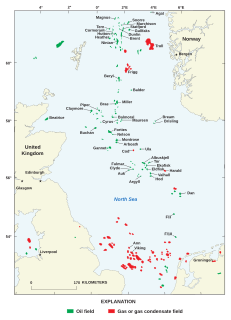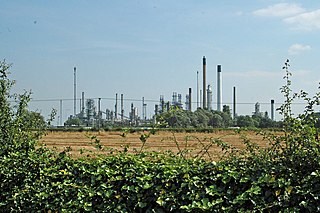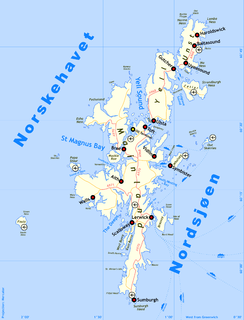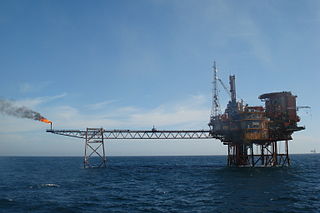History
UK oil production

The UK's first oil field was discovered in the East Midlands, at Hardstoft in east Derbyshire in 1919. Prior to this, from 1851, oil shale in the Midland Valley in Scotland was used, until 1962. With North Sea oil, Britain became self-sufficient with oil and became a net exporter of oil in 1981, with exports peaking in 1985 and production peaking in 1999. The UK became a net exporter of gas in 1997 and a net importer of gas in 2004, and also a net importer of oil in 2004. [1] UK consumption of petroleum increases each year. Per capita consumption of oil annually is about 1.3 tonnes. The UK has the capacity to refine 92 million tonnes of crude oil a year.
Currently the North Sea is producing around 1.5m barrels of oil a day. The peak was in 2000 at 4.5m a day. The Brent oilfield is being decommissioned. The United Kingdom Continental Shelf has reserves of between 12 - 24bn barrels. In 2014, around 14% of the UK's gas came from Russia via Ukraine.
Onshore oil
Until 1990, relatively little oil was produced by UK onshore oil industry. This rapidly increased to peak between 1991 and 1999, where around 5 million tonnes of oil was produced each year - 5.4 million tonnes, the most, was produced in 1996. Since 1999 it has gradually declined to around 1 million tonnes a year. Onshore UK natural gas peaked in 2001. Cumulatively, onshore oil production has produced around 2% (around 500,000,000 barrels (79,000,000 m3)) of offshore (North Sea) production. The Wytch Farm oil field in Dorset, the largest onshore oilfield in Europe and run by BP, has reserves on its own of around 500,000,000 barrels (79,000,000 m3) of oil. The East Midlands Province provides 11% of UK onshore oil, 65% of the total excluding Wytch farm. So far, the Province has provided around 6 million tonnes of oil. In total, the UK has around 15 million tonnes of onshore oil left.
Although onshore oil reserves are much less, it costs much less to find and develop onshore oil. Depleted onshore oilfields at Gainsborough and Welton will be used for gas storage, of which the UK has little allocated reserves. The UK has reserves of 12 days of gas, compared to 91 days in France and 77 days in Germany.
Discoveries
Oil was discovered at Kelham Hills in the 1920s. In June 1939, BP (then the D'Arcy Exploration Company) discovered oil at Eakring; although this was not announced until September 1944. During the war the field produced over 300,000 tons of oil or 2,250,000 barrels from 170 pumps. [2] Oil was also drilled for during the war at Caunton and Kelham Hills.
Welton Gathering Centre
This is actually at Reepham near Sudbrooke on railway, and opened on 21 May 1986 by Alick Buchanan-Smith, the Energy minister. Production began at 600 barrels (95 m3) of oil per day, rising to 3,000. The Centre is the home of Star Energy (East Midlands) Ltd on Barfield Lane. In the early 1990s, a 1,000 tonnes of oil was taken on a train to Immingham every other day. When building the centre, BP discovered a 15-foot (4.6 m) plesiosaurus which was displayed in Scunthorpe Natural History Museum.
Oil companies
BP acquired Candecca Resources and Cambrian Exploration from Trafalgar House in July 1987 for £21m. Candecca Resources Ltd was a subsidiary of BP. It was bought by Kelt UK Ltd in April 1992. Kelt UK Ltd was a subsidiary of Kelt Energy plc and Edinburgh Oil and Gas plc.
Most of the oilfield licences were owned by BP Exploration, when they were bought by Pentex Oil of Aberdeen in March 1989. Star Energy bought Pentex Oil in August 2005 for £38.5m.















